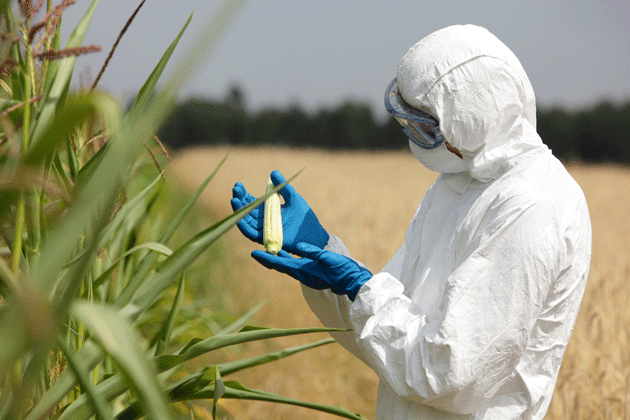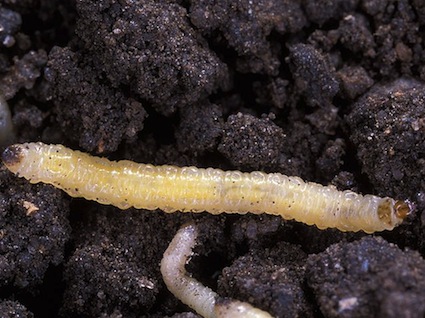
<a href="http://www.shutterstock.com/pic-148936832/stock-photo-biotechnology-engineer-examining-immature-corn-cob-on-field.html?src=tpdMy8rMMzoDcH3et5llJA-1-3" target="_blank">Marcin Balcerzak</a>/Shutterstock
Over the weekend, listservs, blogs, and Twitter feeds lit up with reactions to Amy Harmon’s New York Times deep dive into the politics behind a partial ban on growing genetically modified crops on Hawaii’s main island. The fuss obscured a much more significant development that occurred with little fanfare (and no Times attention) on Friday, when the US Department of Agriculture took a giant step toward approving a controversial new crop promoted by Dow Agrosciences that could significantly ramp up the chemical war on weeds being waged in the Midwest’s corn and soybean fields. Since the ’90s, the widespread use of corn and soy crops genetically engineered to withstand the herbicide Roundup has led more weeds to resist that chemical. Farmers have responded by using even more chemicals, as this Food and Water Watch chart shows.

Dow’s new product promises to fix that problem. The company is peddling corn and soy seeds engineered to withstand not just Roundup, but also an older and much more toxic herbicide called 2,4-D. In a January 3 press release, the company noted that “an astonishing 86 percent of corn, soybean and cotton growers in the South have herbicide-resistant or hard-to-control weeds on their farms,” as do more than 61 percent of farms in the Midwest. “Growers need new tools now to address this challenge,” Dow insisted.
Use of 2,4-D—the less toxic half of the infamous Vietnam-era defoliant Agent Orange—had been dwindling for years, but the rise of Roundup-resistant superweeds has revived it.

Farmers have been using it to “burn down” superweed-ridden fields before the spring planting of corn and soybeans. But if Dow gets its way, they’ll be able to resort to it even after the crops emerge. Dow has downplayed the concern that the new products will lead weeds to develop resistance to 2,4-D. But in a 2011 paper (abstract here), weed experts from Penn State University—hardly a hotbed of anti-GMO activism—concluded that chances are “actually quite high” that Dow’s new product will unleash a new plague of super-duper-weeds that resist both Roundup and 2,4-D. (I laid out the details of their argument in this post.) Here’s their model for how the new product would affect herbicide application rates on soybeans. Note how they project that glyphosate (Roundup) use will hold steady, but that “other herbicides,” mostly 2,4-D, will spike—meaning a windfall for Dow but nothing good for the environment.

The USDA, which oversees the introduction of new GMO crops, appeared set to green-light Dow’s new wonderseeds at the end of 2012. But in May of last year, after a firestorm of criticism from environmental groups, the department slowed down the process, announcing in a press release it had decided that release of the novel products “may significantly affect the quality of the human environment,” and that a thorough environmental impact statement (EIS) was necessary before such a decision could be made.
Then on Friday, the USDA reversed itself—it released the draft of the promised EIS, and in it, the department recommended that Dow’s 2,4-D-ready crops be unleashed upon the land. Once the draft is published in the Federal Register on January 10, there will be a 45-day public comment period, after which the USDA will make its final decision. At this point, approval seems imminent—probably in time for the 2015 growing season, as Dow suggested in its press release reacting to the news.
Why did the USDA switch from “may significantly affect the quality of the human environment” to a meek call for deregulation? As the USDA itself admits in its Friday press release, the department ultimately assesses new GMO crops through an extremely narrow lens: whether or not they act as a “pest” to other plants—that is, they’ll withhold approval only if the crops themselves, and not the herbicide tsunami and upsurge in resistant weeds they seem set to bring forth, pose a threat to other plants. And Dow’s new corn and soy crops don’t cross that line, the USDA claims. I explained the tortured history and logic behind the USDA’s “plant pest” test in this 2011 post. Long story short: It’s an antiquated, fictional standard that doesn’t allow for much actual regulation.
US farmers planted about 170 million acres of corn and soy in 2013—a combined land mass roughly equal to the footprint of Texas. Every year, upwards of 80 percent of it is now engineered to resist Monsanto’s Roundup. It’s chilling to imagine that Dow’s 2,4-D-ready products might soon enjoy a similar range.
Given the USDA’s regulatory impotence in the face of such a specter, perhaps the Hawaiian activists who pushed for that ban aren’t quite as daft as the New York Times portrayed them in its recent piece. The big biotech companies don’t operate on the island that imposed the partial ban on GMOs. But as another New York Times piece, this one from 2011, shows, they do operate on other islands within the state—using them as a testing ground for novel crops and a place to grow out GMO seeds, taking advantage of the warm climate that allows several crops per year. According to the Times, GMO seeds are now bigger business in Hawaii than tropical staples like coffee, sugarcane, and pineapples—and the GMO/agrichemical giants have “have stepped into the leading, and sometimes domineering role, once played by the islands’ sugar barons.” As for Dow, it cops to having field-tested its 2,4-D-ready corn there.














